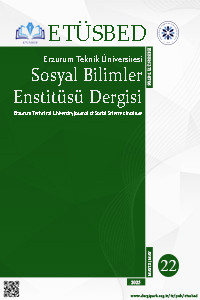Abstract
İlk kez 1955 yılında Letterist International'ın kurucusu Guy Debord tarafından ortaya atılan psikocoğrafya, bir kentin bireyler üzerindeki psikolojik ve duygusal etkilerinin incelenmesiyle kesişmektedir. Mekân ve psikolojinin birbirini tamamladığını öne süren psikocoğrafya, psikoloji ve coğrafyayı yan yana getiren bir terim olarak, ileri kapitalizm ve sanayileşme ile pekişen küresel şehirciliğin yabancılaştırıcı ve insanlığı soyutlaştıran etkilerini ortaya çıkarmayı amaçlar. Bu anlamda psikocoğrafya, zihin ve şehir arasında süregelen çatışmayı anlamak için çoğunlukla yürüme eylemine odaklanır ve bilinçli bir faaliyet olarak düşünülen yürümenin şehrin insanı metalaştırmasına ve baskıcı kısıtlamalarına karşı bir protesto ve yıkım işlevi görebileceğini öne sürer. Benzer şekilde Iris Murdoch’un Ağ adlı ilk romanı, Jake Donaghue’ın Londra gibi bir kent oluşumunun etkisiyle yabancılaşan ve yersiz yurtsuzlaşan dengesiz psikolojisinin öyküsünü ele almaktadır. Dolayısıyla bu çalışma, Iris Murdoch'un Ağ romanını psikocoğrafi bir bakış açısı kullanarak küresel kentleşme doğrultusunda bireylerin parçalanmasını ve yerinden edilmesini vurgulamak amacıyla analiz etmeyi hedeflemektedir.
Keywords
References
- Ball, E. (1987). “The Great Sideshow of the Situationist International”. Yale French Studies, 73 (1), 21-37.
- Baptista, L. A. S. (2013). “The cities of need: capitalism and subjectivity in the contemporary metropolis”. Psicologia & Sociedade, 25 (1), 54-61.
- Barnard, A. (2004). “The Legacy of The Situationist International: The Production of Situations of Creative Resistance”. Capital and Class, 28 (3), 103-124.
- Barreiro León, B. (2017). “Urban theory in postmodern cities: Amnesiac spaces and ephemeral aesthetics”. Revista de Estudios Urbanos y Ciencias Sociales, 7 (1), 57-65.
- Bentley, N. (2014). “Postmodern Cities”. Kevin R. McNamara (Ed), The Cambridge Companion to the City in Literature. Cambridge: Cambridge University Press, 175-187.
- Beville, M. (2013). “Zones of Uncanny Spectrality: The City in Postmodern Literature”. English Studies, 94 (5), 603-617.
- Bove, C., & Rowe, A. (2008). Sacred Space, Beloved city: Iris Murdoch’s London. Cambridge: Cambridge Scholars Publishing.
- Chatterton, P. (2016). “Building transitions to post-capitalist urban commons”. Transactions of the Institute of British Geographers, 41 (4), 403-415.
- Coverley, M. (2006). Psychogeography. Harpenden: Pocket Essentials.
- Hopkins, D. (2004). Dada and Surrealism: A Very Short Introduction. Oxford: Oxford University Press.
- Debord, G. (2006). “Theory of the Derive”. Ken Knabb (Ed), Situationist International Anthology. Berkeley: Bureau of Public Secrets, 62-66.
- Debord, G. (2014). The Society of the Spectacle. Berkeley: Bureau of Public Secrets.
- Gassner, G. (2017). “Wrecking London’s skyline? A political critique of how the city is viewed”. City, 21 (6), 754-768.
- Kilner-Johnson, A. (2025). “Contingency and the Categorical Imperative in Iris Murdoch’s Under the Net”. Critique: Studies in Contemporary Fiction, 1-10.
- Lagomasino, A. (2020). “Dérive: Place-making Practices on Foot”. Liminalities: A Journal of Performance Studies, 16 (4), 1-15.
- Lavery, C. (2018). “Rethinking the Dérive”. Performance Research, 23 (7), 1-15.
- Lefebvre, H. (2003). The Urban Revolution. Minneapolis: University of Minnesota Press.
- Madanipour, A. (2010). “Connectivity and contingency in planning”. Planning Theory, 9 (4), 351-368.
- Murdoch, I. (2002). Under the Net. London: Vintage Classics.
- Richarson, T. (2015). Walking Inside Out: Contemporary British Psychogeography. New York: Rowman & Littlefield.
- Sizemore, C. W. (1989). A Female Vision of the City: London in the Novels of Five British Women. Tennessee: University of Tennessee Press.
- Wollen, P. (1989). “Bitter Victory: The Art and Politics of the Situationist International”. Elisabeth Sussman (Ed), On the Passage of a Few People through a Rather Brief Moment in Time: The Situationist International, 1957–1972. Massachusetts: MIT Press, 20-61.
- Yalçın, E. (2023). “Modern ve Postmodern Kent”. Toplum, Ekonomi ve Yönetim Dergisi, 4 (1), 163-180.
Abstract
Introduced firstly by Guy Debord, the founder of the Letterist International, in 1955, psychogeography intersects with the study of the psychological and emotional effects of an urban city on individuals. Proposing that both space and psychology complete one another, psychogeography, as a term juxtaposing psychology and geography, seeks to unearth the estrangement and the dehumanizing impacts of global urbanism consolidated by advanced capitalism and industrialization. In this sense, psychogeography focuses mostly on the act of walking so as to comprehend the ongoing conflict between the mind and city and suggests walking as a conscious activity can function as a protest and subversion against the commodification and repressive constraints of the city. Likewise, Iris Murdoch's debut novel titled Under the Net captures the story of Jake Donaghue and his unstable psychology alienated and decentred by the formation of an urban city, that is, London. Thus, this study aims to analyze Iris Murdoch's Under the Net in order to emphasize the fragmentation and displacement of individuals in accordance with the global urbanism by employing a psychogeographical lens.
Keywords
References
- Ball, E. (1987). “The Great Sideshow of the Situationist International”. Yale French Studies, 73 (1), 21-37.
- Baptista, L. A. S. (2013). “The cities of need: capitalism and subjectivity in the contemporary metropolis”. Psicologia & Sociedade, 25 (1), 54-61.
- Barnard, A. (2004). “The Legacy of The Situationist International: The Production of Situations of Creative Resistance”. Capital and Class, 28 (3), 103-124.
- Barreiro León, B. (2017). “Urban theory in postmodern cities: Amnesiac spaces and ephemeral aesthetics”. Revista de Estudios Urbanos y Ciencias Sociales, 7 (1), 57-65.
- Bentley, N. (2014). “Postmodern Cities”. Kevin R. McNamara (Ed), The Cambridge Companion to the City in Literature. Cambridge: Cambridge University Press, 175-187.
- Beville, M. (2013). “Zones of Uncanny Spectrality: The City in Postmodern Literature”. English Studies, 94 (5), 603-617.
- Bove, C., & Rowe, A. (2008). Sacred Space, Beloved city: Iris Murdoch’s London. Cambridge: Cambridge Scholars Publishing.
- Chatterton, P. (2016). “Building transitions to post-capitalist urban commons”. Transactions of the Institute of British Geographers, 41 (4), 403-415.
- Coverley, M. (2006). Psychogeography. Harpenden: Pocket Essentials.
- Hopkins, D. (2004). Dada and Surrealism: A Very Short Introduction. Oxford: Oxford University Press.
- Debord, G. (2006). “Theory of the Derive”. Ken Knabb (Ed), Situationist International Anthology. Berkeley: Bureau of Public Secrets, 62-66.
- Debord, G. (2014). The Society of the Spectacle. Berkeley: Bureau of Public Secrets.
- Gassner, G. (2017). “Wrecking London’s skyline? A political critique of how the city is viewed”. City, 21 (6), 754-768.
- Kilner-Johnson, A. (2025). “Contingency and the Categorical Imperative in Iris Murdoch’s Under the Net”. Critique: Studies in Contemporary Fiction, 1-10.
- Lagomasino, A. (2020). “Dérive: Place-making Practices on Foot”. Liminalities: A Journal of Performance Studies, 16 (4), 1-15.
- Lavery, C. (2018). “Rethinking the Dérive”. Performance Research, 23 (7), 1-15.
- Lefebvre, H. (2003). The Urban Revolution. Minneapolis: University of Minnesota Press.
- Madanipour, A. (2010). “Connectivity and contingency in planning”. Planning Theory, 9 (4), 351-368.
- Murdoch, I. (2002). Under the Net. London: Vintage Classics.
- Richarson, T. (2015). Walking Inside Out: Contemporary British Psychogeography. New York: Rowman & Littlefield.
- Sizemore, C. W. (1989). A Female Vision of the City: London in the Novels of Five British Women. Tennessee: University of Tennessee Press.
- Wollen, P. (1989). “Bitter Victory: The Art and Politics of the Situationist International”. Elisabeth Sussman (Ed), On the Passage of a Few People through a Rather Brief Moment in Time: The Situationist International, 1957–1972. Massachusetts: MIT Press, 20-61.
- Yalçın, E. (2023). “Modern ve Postmodern Kent”. Toplum, Ekonomi ve Yönetim Dergisi, 4 (1), 163-180.
Details
| Primary Language | English |
|---|---|
| Subjects | British and Irish Language, Literature and Culture |
| Journal Section | Research Article |
| Authors | |
| Early Pub Date | May 29, 2025 |
| Publication Date | May 31, 2025 |
| Submission Date | June 26, 2024 |
| Acceptance Date | May 15, 2025 |
| Published in Issue | Year 2025 Issue: 22 |




